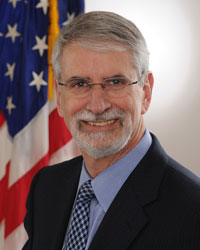Health Information Exchange: From Standards to Practice
By David Muntz, MBA / Principal Deputy National Coordinator for Health IT
The recent release of the Stage 2 Meaningful Use final rule includes an important requirement: Health care providers should be able to exchange information electronically using his or her electronic health record (EHR). By 2014, a provider attesting to Meaningful Use Stage 2 should be able use their EHR to share an electronic copy of a care summary and relevant documentation with another provider, regardless of which vendor produced the EHR that either is using. In addition, patients should be able to view, download, and transmit their personal health information from an EHR to a personally controlled health record or another provider.
Health Information Exchange Standards
In order to make this type of interoperable health information exchange possible, the health IT community needs a core set of standards and specifications that enable EHRs to communicate seamlessly. Recognizing this need, ONC has been diligently working to ensure that the health information exchange standards for vocabulary, message packaging, and message transport are available to providers for this purpose. In addition, ONC’s efforts have recently turned to optimizing implementation guidance for these standards. Developing a portfolio of these standards and specifications, and creating strong guidance on how to implement them is among the most critical work being done in health IT today.
The First Step: Create the Building Blocks
ONC discovered that providing a mechanism for the community to come together to solve problems was a successful way to accelerate the development of consensus on standards and specifications. Through the S&I Framework, the health IT community is developing and harmonizing the standards and specifications needed to support interoperability. Our role in government is to provide conditions in which others in the community can succeed in helping to solve critical health IT challenges.
The statistics of the S&I Framework’s activities are astounding. More than 1,300 people are registered on the S&I wiki, with more than 500 committed participants who attend at least weekly calls dedicated to moving forward a growing portfolio of 13 initiatives in process. More than 800 working sessions have been held, resulting in more than 30 use case artifacts and 20 pilots in discovery, as well as three HL7 ballots.
What these numbers mean to those who are not familiar with the world of standards is that the community is completing a tremendous amount of work in a relatively short period of time. Before we had a forum for convening, it was hard to solve a particular problem in a standards-based way, particularly when the solution spanned different standards development organizations. In fact, through the S&I Framework process, the standards development lifecycle can be, as has been demonstrated, slashed in half – down from 18-36 months to 9-18 months.
Ensuring Standards Compliance Is the Next Step
As the standards are developed and agreed upon by the health IT community, ONC must ensure that EHR technologies meet those adopted standards in order to ensure that providers and hospitals achieve meaningful use objectives and measures that are established by the Centers for Medicare & Medicaid Services (CMS). That is the purpose of ONC’s Certification Program.
Certification of health information technology provides assurance to purchasers and other users that an EHR system offers the necessary technological capability, functionality, and security to help them meet MU objectives and measures. Certification also gives providers and patients confidence that the products and systems they use are secure and can work with other systems to share information. To date, ONC has certified many different types of ambulatory and inpatient EHR products from numerous vendors, providing this assurance to the country.
Visit HealthIT.gov for more information about ONC’s Certification program and the interoperability testing requirements.
The End Goal: Implementation and Interoperability
As I mentioned earlier, developing health information exchange standards is only one part of the puzzle. If the standards are not adopted, then interoperable health information exchange won’t be possible. Support for on-the-ground implementers in assembling standards and policy building blocks to solve providers’ most pressing information exchange needs is a key component to ensuring success.
As these early implementations produce results, disseminating and spreading the health information exchange solutions will ensure that a wide array of implementation guidance is available to providers looking to engage in health information exchange.
Finally, we will continue to advance standards adoption through meaningful use and other federal policy levers that assist providers with securing health information technology and utilizing it to its fullest potential. As Dr. Farzad Mostashari, the National Coordinator for Health Information Technology, likes to say, the push on standards-based information exchange and other Meaningful Use Stage 2 requirements will allow the country to “make meaningful use of the meaningful use roadmap” for more coordinated, safer, and better care.
The work of ONC will continue to support the community of stakeholders and the needs of patients. More and more functionality will come as we grow the portfolio of standards in response to priorities that are set forth by the health IT community. As this happens, our Certification Program will also evolve to ensure that the country’s health IT products conform to these agreed-upon standards. And finally, our work supporting implementation in the field will continue to be a core part of our health information exchange strategy.
There are many examples over the past year where our State HIE and Beacon Grantees have come together to work on a particular interoperability implementation strategy, like lab over direct and transitions of care. It is exciting and humbling to watch this work unfold.
For More Information
We’re always looking for passionate members from the health IT community to participate in this work. To learn more about health information exchange standards, please visit www.healthit.gov and www.siframework.org.

